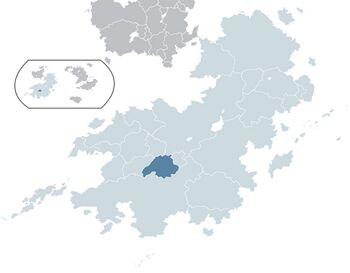Kathastan
This article is incomplete because it is pending further input from participants, or it is a work-in-progress by one author. Please comment on this article's talk page to share your input, comments and questions. Note: To contribute to this article, you may need to seek help from the author(s) of this page. |
United Republic of Sinharia | |
|---|---|
Flag
| |
Motto:
| |
Anthem:
| |
 Location of Sinharia in Coius | |
| Capital | Karatan |
| Official languages | Sinhari |
| Recognised regional languages | Pardarian |
| Ethnic groups (2014) | Sinhari (58.5%) Pardarians (31.9%) Yanogu (6.2%) Tagoti (2.3%) Xiaodongese (0.7%) Other (0.4%) |
| Religion (2014) | Irfan (64.9%) Badi (25.3%) Traditional beliefs (2.9%) Other/Irreligious (6.9%) |
| Demonym(s) | Sinhari |
| Government | Federal dominant-party presidential republic |
| Nariman Atasar | |
• Deputy President | TBA |
| Legislature | Parliament |
| People's Council | |
| National Assembly | |
| Independence from Etruria | |
• Dissolution of the Shahdom of Pardaran | 1946 |
• Admission to the Community of Nations | 14 October 1949 |
• Current Constitution | 15 September 1989 |
| Area | |
• Total | 786,258 km2 (303,576 sq mi) |
• Water (%) | 2.2% |
| Population | |
• 2020 estimate | 10,342,069 |
• 2014 census | 9,287,178 |
• Density | 11.8/km2 (30.6/sq mi) |
| GDP (PPP) | 2020 estimate |
• Total | $335 billion |
• Per capita | $32,384 |
| GDP (nominal) | 2020 estimate |
• Total | $119 billion |
• Per capita | $11,492 |
| Gini (2018) | 29.7 low |
| HDI (2019) | 0.774 high |
| Currency | Tang (STA) |
| Date format | dd-mm-yyyy (AD) |
| Driving side | left |
| Calling code | +103 |
| Internet TLD | .sin |
Sinharia, officially the United Republic of Sinharia (Sinhari: Sınhariya Birikken Respwblykasy) is a landlocked country in south-central Coius. Largely located on the Central Coian Steppe, it is bordered by x to the north, Zorasan and Kumuso to the east, Xiaodong to the south, and Ajahadya and Dakata to the west. With a population density of less than 12 people per square kilometer, it is one of the most thinly populated countries in the world. 2020 estimates place Sinharia's population at approximately 10.3 million people, making it the 10th most populous nation in Coius and the TBAth most populous in the world. With an area of just over 786 thousand square kilometers, it is the TBAth largest nation in the world. Its land area is dominated by arid grasslands, transitioning into a cold desert climate in the north-western regions.
Sinharia has been inhabited by nomadic peoples for millennia, with the myriad Sinhari tribes banding together into the Sinhari Confederation in the 15th century to ward off foreign aggression. This early attempt at a unified Sinhari state collapsed in the 17th century as the Gorsanids expanded into the Coian Steppe, and Sinharia would remain a province of the Gorsanid Empire until the latter's collapse in the 19th century. Following the withdrawl of the Gorsanids from Sinharia after the 1827-1844 Second Sinhari War, there were numerous attempts to once again unite the Sinhari people under one banner; these largely failed due to internal divisions, and Sinharia was incorporated into the Etruria-controlled Shahdom of Pardaran in the 1870s. Under Etrurian rule, Sinharia's vast natural gas reserves were discovered and began to be exploited. However, this newfound wealth was largely diverted to the Shahdom and to the Etrurian government, with Sinharia remaining an impoverished rural backwater.
Following the Solarian War, Etruria granted independence to its colonial possessions in Coius as per the Treaty of Ashcombe, and Sinharia became an independent nation for the first time in 300 years. This newfound independence was short-lived, however, with Pardaran attempting to annex the new nation almost immediately after its independence. The devastating Third Sinhari War of 1946-1948 saw Pardaran quickly gain the upper hand, especially in the majority-Pardarian northern areas of the country, but Pardarian forces were forced to withdraw from Sinharia in 1948 due to the outbreak of the Pardarian Civil War. The new Sinhari government quickly collapsed under the weight of government corruption and fractious inter-ethnic relations, culminating in a 1965 coup that saw a communist government under the rule of Marat Zanhur take power in Sinharia. The socialist government eventually collapsed in a 1990 popular revolution, resulting in the establishment of a new government and the first multi-party elections in 25 years.
Since the end of communist rule in 1990, Sinharia has been a federal presidential republic ruled by Nariman Atasar and the Sinhari Future Alliance. The country has a poor record on human rights and is widely considered among the most politically repressive nations in the world, regularly ranking near the bottom of human rights indexes due to rampant corruption and pervasive censorship of the national media. Many cite Sinharia as an example of a petrostate and southern democracy. The Sinhari economy is dominated by the oil and gas industry, which together account for over 60% of Sinharia's GDP and over 90% of its exports.
